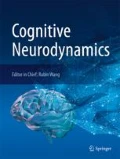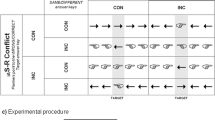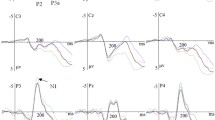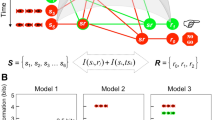Abstract
Behavioral studies using the flanker 2-1 mapping task suggest that both stimulus and response conflicts contribute to flanker conflict effect. However, both are intertwined with distraction effect. Their underlying neural mechanisms remain unclear. We applied a perceptual flanker 2-1 mapping task to 24 healthy young adults, while the event-related potentials were recorded. The task included stimulus-incongruent (SI), response-incongruent (RI), congruent (CO) and neutral (NE) stimuli. Our reaction time data demonstrated conflict effect, distraction effect and their interaction. Furthermore, the conflict factor successively enhanced the frontal P2 (160–240 ms), the posterior N2pc (200–240 ms), the fronto-central and the right frontal N2b (240–420 ms), and the posterior N2c (320–420 ms). Only the frontal P2 was larger for RI than SI. The distraction factor increased the right N2pc and reduced the left parietal P3b (460–480 ms). Overall, our findings suggested that the flanker conflict involved an early attentional processing of task-relevant and distractive information, and a later processing of conflict evaluation and response inhibition.





Similar content being viewed by others
References
Aron AR (2011) From reactive to proactive and selective control: developing a richer model for stopping inappropriate responses. Biol Psychiatry 69(12):e55–e68
Bari A, Robbins TW (2013) Inhibition and impulsivity: behavioral and neural basis of response control. Prog Neurobiol 108:44–79
Bartholow BD, Pearson MA, Dickter CL, Sher KJ, Fabiani M, Gratton G (2005) Strategic control and medial frontal negativity: Beyond errors and response conflict. Psychophysiology 42(1):33–42
Beaton LE, Azma S, Marinkovic K (2018) When the brain changes its mind: oscillatory dynamics of conflict processing and response switching in a flanker task during alcohol challenge. PLoS ONE 13(1):e191200
Botvinick MM, Cohen JD, Carter CS (2004) Conflict monitoring and anterior cingulated cortex: an update. Trends Cogn Sci 8:539–546
Cespon J, Galdo-Alvarez S, Diaz F (2013a) N2pc is modulated by stimulus-stimulus, but not by stimulus-response incompatibilities. Biol Psychol 93(1):75–80
Cespon J, Galdo-Alvarez S, Diaz F (2013b) Age-related changes in ERP correlates of visuospatial and motor processes. Psychophysiology 50(8):743–757
Cieslik EC, Mueller VI, Eickhoff CR, Langner R, Eickhoff SB (2015) Three key regions for supervisory attentional control: evidence from neuroimaging meta-analyses. Neurosci Biobehav Rev 48:22–34
Clayson PE, Larson MJ (2011a) Conflict adaptation and sequential trial effects: support for the conflict monitoring theory. Neuropsychologia 49:1953–1961
Clayson PE, Larson MJ (2011b) Effects of repetition priming on neurophysiological and behavioral indices of conflict adaptation and cognitive control. Psychophysiology 48:1621–1630
Cosman JD, Atreya PV, Woodman GF (2015) Transient reduction of visual distraction following electrical stimulation of the prefrontal cortex. Cognition 145:73–76
Cosman JD, Lowe KA, Zinke W, Woodman GF, Schall JD (2018) Prefrontal control of visual distraction. Curr Biol 28(3):414–420
De Houwer J (2003) On the role of stimulus-response and stimulus-stimulus compatibility in the Stroop effect. Mem Cogn 31(3):353–359
De Jong R, Liang CC, Lauber E (1994) Conditional and unconditional automaticity: a dual-process model of effects of spatial stimulus-response correspondence. J Exp Psychol Hum Percept Perform 20(4):731–750
Diamond A (2013) Executive functions. Annu Rev Psychol 64:135–168
Donohue SE, Appelbaum LG, McKay CC, Woldorff MG (2016) The neural dynamics of stimulus and response conflict processing as a function of response complexity and task demands. Neuropsychologia 84:14–28
Doucet C, Stelmack RM (1999) The effect of response execution on P3 latency, reaction time, and movement time. Psychophysiology 36(3):351–363
Eimer M (1996) The N2pc component as an indicator of attentional selectivity. Electroencephalogr Clin Neurophysiol 99(3):225–234
Eriksen BA, Eriksen CW (1974) Effects of noise letters upon the identification of a target letter in a nonsearch task. Percept Psychophys 16(1):143–149
Eriksen CW, St James JD (1986) Visual attention within and around the field of focal attention: a zoom lens model. Percept Psychophys 40:225–240
Folstein JR, Van Petten C (2008) Influence of cognitive control and mismatch on the N2 component of the ERP: a review. Psychophysiology 45(1):152–170
Forster SE, Carter CS, Cohen JD, Cho RY (2011) Parametric manipulation of the conflict signal and control-state adaptation. J Cogn Neurosci 23(4):923–935
He X, Witzel C, Forder L, Clifford A, Franklin A (2014) Color categories only affect post-perceptual processes when same- and different-category colors are equally discriminable. J Opt Soc Am A Opt Image Sci Vis 31(4):A322–A331
Kałamała P, Szewczyk J, Senderecka M, Wodniecka Z (2018) Flanker task with equiprobable congruent and incongruent conditions does not elicit the conflict N2. Psychophysiology. https://doi.org/10.1111/psyp.12980
Kim C, Kroger JK, Kim J (2011) A functional dissociation of conflict processing within anterior cingulate cortex. Hum Brain Mapp 32(2):304–312
Kok A (2001) On the utility of P3 amplitude as a measure of processing capacity. Psychophysiology 38(3):557–577
Kornblum S (1994) The way irrelevant dimensions are processed depends on what they overlap with: the case of Stroop- and Simon-like stimuli. Psychol Res 56:130–135
Kornblum S, Lee JW (1995) Stimulus-response compatibility with relevant and irrelevant stimulus dimensions that do and do not overlap with the response. J Exp Psychol Hum Percept Perform 21(4):855–875
Korsch M, Fruhholz S, Herrmann M (2016) Conflict-specific aging effects mainly manifest in early information processing stages—an ERP study with different conflict types. Front Aging Neurosci 8:53
Larson MJ, Clayson PE, Clawson A (2014) Making sense of all the conflict: a theoretical review and critique of conflict-related ERPs. Int J Psychophysiol 93(3):283–297
Li V, Michael E, Balaguer J, Herce Castañón S, Summerfield C (2018) Gain control explains the effect of distraction in human perceptual, cognitive, and economic decision making. Proc Natl Acad Sci 115(38):E8825–E8834
Lins OG, Picton TW, Berg P, Scherg M (1993a) Ocular artifacts in EEG and event-related potentials. I: scalp topography. Brain Topogr 6(1):51–63
Lins OG, Picton TW, Berg P, Scherg M (1993b) Ocular artifacts in recording EEGs and event-related potentials. II: source dipoles and source components. Brain Topogr 6(1):65–78
Liu Q, Li H, Campos JL, Wang Q, Zhang Y, Qiu J, Zhang Q, Sun HJ (2009) The N2pc component in ERP and the lateralization effect of language on color perception. Neurosci Lett 454(1):58–61
Liu Q, Li H, Campos JL, Teeter C, Tao W, Zhang Q, Sun HJ (2010) Language suppression effects on the categorical perception of colour as evidenced through ERPs. Biol Psychol 85(1):45–52
Lu A, Yang L, Yu Y, Zhang M, Shao Y, Zhang H (2014) Event-related potentials reveal linguistic suppression effect but not enhancement effect on categorical perception of color. Scand J Psychol 55(4):287–295
Luck SJ, Hillyard SA (1994a) Electrophysiological correlates of feature analysis during visual search. Psychophysiology 31:291–308
Luck SJ, Hillyard SA (1994b) Spatial filtering during visual search: evidence from human electrophysiology. J Exp Psychol Hum Percept Perform 20:1000–1014
MacLeod CM, MacDonald PA (2000) Interdimensional interference in the Stroop effect: uncovering the cognitive and neural anatomy of attention. Trends Cogn Sci 4(10):383–391
McDonald JJ, Green JJ, Jannati A, Di Lollo V (2013) On the electrophysiological evidence for the capture of visual attention. J Exp Psychol Hum Percept Perform 39(3):849–860
McKay CC, van den Berg B, Woldorff MG (2017) Neural cascade of conflict processing: not just time-on-task. Neuropsychologia 96:184–191
Nee DE, Wager TD, Jonides J (2007) Interference resolution: insights from a meta-analysis of neuroimaging tasks. Cogn Affect Behav Neurosci 7(1):1–17
Neuhaus AH, Koehler S, Opgen-Rhein C, Urbanek C, Hahn E, Dettling M (2007) Selective anterior cingulate cortex deficit during conflict solution in schizophrenia: an event-related potential study. J Psychiatr Res 41(8):635–644
Neuhaus AH, Urbanek C, Opgen-Rhein C, Hahn E, Ta TM, Koehler S, Gross M, Dettling M (2010) Event-related potentials associated with attention network test. Int J Psychophysiol 76(2):72–79
Nigbur R, Ivanova G, Stürmer B (2011) Theta power as a marker for cognitive interference. Clin Neurophysiol 122(11):2185–2194
Nigbur R, Cohen MX, Ridderinkhof KR, Stürmer B (2012) Theta dynamics reveal domain-specific control over stimulus and response conflict. J Cogn Neurosci 24(5):1264–1674
Parhizi B, Daliri MR, Behroozi M (2018) Decoding the different states of visual attention using functional and effective connectivity features in fMRI data. Cogn Neurodyn 12(2):157–170
Pires L, Leitão J, Guerrini C, Simões MR (2014) Event-related brain potentials in the study of inhibition: cognitive control, source localization and age-related modulations. Neuropsychol Rev 24(4):461–490
Pliszka SR, Liotti M, Woldorff MG (2000) Inhibitory control in children with attention-deficit/hyperactivity disorder: event-related potentials identify the processing component and timing of an impaired right-frontal response-inhibition mechanism. Biol Psychiatry 48:238–246
Potts GF (2004) An ERP index of task relevance evaluation of visual stimuli. Brain Cogn 56(1):5–13
Roberts RE, Anderson EJ, Husain M (2010) Expert cognitive control and individual differences associated with frontal and parietal white matter microstructure. J Neurosci 30(50):17063–17067
Roelofs A, van Turennout M, Coles MG (2006) Anterior cingulate cortex activity can be independent of response conflict in Stroop-like tasks. Proc Natl Acad Sci 103(37):13884–13889
Sharp DJ, Bonnelle V, De Boissezon X, Beckmann CF, James SG, Patel MC, Mehta MA (2010) Distinct frontal systems for response inhibition, attentional capture, and error processing. Proc Natl Acad Sci 107(13):6106–6111
Shulman GL, McAvoy MP, Cowan MC, Astafiev SV, Tansy AP, d’Avossa G, Corbetta M (2003) Quantitative analysis of attention and detection signals during visual search. J Neurophysiol 90(5):3384–3397
Shulman GL, Astafiev SV, McAvoy MP, d’Avossa G, Corbetta M (2007) Right TPJ deactivation during visual search: functional significance and support for a filter hypothesis. Cereb Cortex 17(11):2625–2633
Simon JR, Rudell AP (1967) Auditory S-R compatibility: the effect of an irrelevant cue on information processing. J Appl Psychol 51(3):300–304
Śmigasiewicz K, Asanowicz D, Westphal N, Verleger R (2015) Bias for the left visual field in rapid serial visual presentation: effects of additional salient cues suggest a critical role of attention. J Cogn Neurosci 27(2):266–279
Sohn MH, Albert MV, Jung K, Carter CS, Anderson JR (2007) Anticipation of conflict monitoring in the anterior cingulate cortex and the prefrontal cortex. Proc Natl Acad Sci 104(25):10330–10334
Stroop JR (1935) Studies of interference in serial verbal reactions. J Exp Psychol 18:643–662
Suwazono S, Machado L, Knight RT (2000) Predictive value of novel stimuli modifies visual event-related potentials and behavior. Clin Neurophysiol 111:29–39
Szucs D, Soltész F (2010) Stimulus and response conflict in the color-word Stroop task: a combined electro-myography and event-related potential study. Brain Res 1325:63–76
Tillman CM, Wiens S (2011) Behavioral and ERP indices of response conflict in Stroop and flanker tasks. Psychophysiology 48:1405–1411
Todd JJ, Fougnie D, Marois R (2005) Visual short-term memory load suppresses temporo-parietal junction activity and induces inattentional blindness. Psychol Sci 16(12):965–972
van Veen V, Carter CS (2002) The timing of action-monitoring processes in the anterior cingulate cortex. J Cogn Neurosci 14(4):593–602
van Veen V, Carter CS (2005) Separating semantic conflict and response conflict in the Stroop task: a functional MRI study. Neuroimage 27(3):497–504
van Veen V, Cohen JD, Botvinick MM, Stenger VA, Carter CS (2001) Anterior cingulate cortex, conflict monitoring, and levels of processing. Neuroimage 14(6):1302–1308
Verbruggen F, Logan GD (2008) Response inhibition in the stop-signal paradigm. Trends Cogn Sci 12(11):418–424
Verleger R, Smigasiewicz K, Moller F (2011) Mechanisms underlying the left visual-field advantage in the dual stream RSVP task: evidence from N2pc, P3, and distractor-evoked VEPs. Psychophysiology 48(8):1096–1106
Verleger R, Dittmer M, Smigasiewicz K (2013) Cooperation or competition of the two hemispheres in processing characters presented at vertical midline. PLoS ONE 8(2):e57421
Weeks DJ, Proctor RW, Beyak B (1995) Stimulus-response compatibility for vertically oriented stimuli and horizontally oriented responses: evidence for spatial coding. Q J Exp Psychol A 48(2):367–383
Wendt M, Heldmann M, Munte TF, Kluwe RH (2007) Disentangling sequential effects of stimulus- and response-related conflict and stimulus-response repetition using brain potentials. J Cogn Neurosci 19(7):1104–1112
Wendt M, Luna-Rodriguez A, Jacobsen T (2014) Utility-based early modulation of processing distracting stimulus information. J Neurosci 34(50):16720–16725
Zheng D, Oka T, Bokura H, Yamaguchi S (2008) The key locus of common response inhibition network for no-go and stop signals. J Cogn Neurosci 20(8):1434–1442
Zhou S, Wei JH, Luo YF, Yang WJ (1998) New methods for three dimensional mapping of brain waves. Brain Topogr 11(2):103–110
Zhou S, Zhou W, Chen X (2004) Spatiotemporal analysis of ERP during Chinese idiom comprehension. Brain Topogr 17(1):27–37
Acknowledgements
The authors are indebted to the anonymous reviewers for helpful comments on this manuscript. This research was supported by Grants from the Nature Science Foundation of China (81200962) and the President Foundation of Nanfang Hospital at Southern Medical University (No. 2014Z009).
Author information
Authors and Affiliations
Corresponding authors
Ethics declarations
Conflict of interest
The authors declare that they have no conflict of interest.
Ethical approval
All procedures performed in studies involving human participants were in accordance with the ethical standards of the institutional and/or national research committee and with the 1964 Helsinki declaration and its later amendments or comparable ethical standards. This article does not contain any studies with animals performed by any of the authors.
Additional information
Publisher's Note
Springer Nature remains neutral with regard to jurisdictional claims in published maps and institutional affiliations.
Electronic supplementary material
Below is the link to the electronic supplementary material.
11571_2019_9529_MOESM1_ESM.tif
Grand average ERP waveforms (from − 100 to 600 ms) are shown for 19 electrodes across all trial types, from the 24 subjects. The blue, green, red and purple traces correspond to group average ERP of the NE, CO, SI and RI conditions respectively. The baseline ERP measurement is the mean amplitude of 100 ms pre-stimulus interval. (TIFF 46 kb)
Rights and permissions
About this article
Cite this article
Zhou, S., Xiong, S., Cheng, W. et al. Flanker paradigm contains conflict and distraction factors with distinct neural mechanisms: an ERP analysis in a 2-1 mapping task. Cogn Neurodyn 13, 341–356 (2019). https://doi.org/10.1007/s11571-019-09529-w
Received:
Revised:
Accepted:
Published:
Issue Date:
DOI: https://doi.org/10.1007/s11571-019-09529-w




